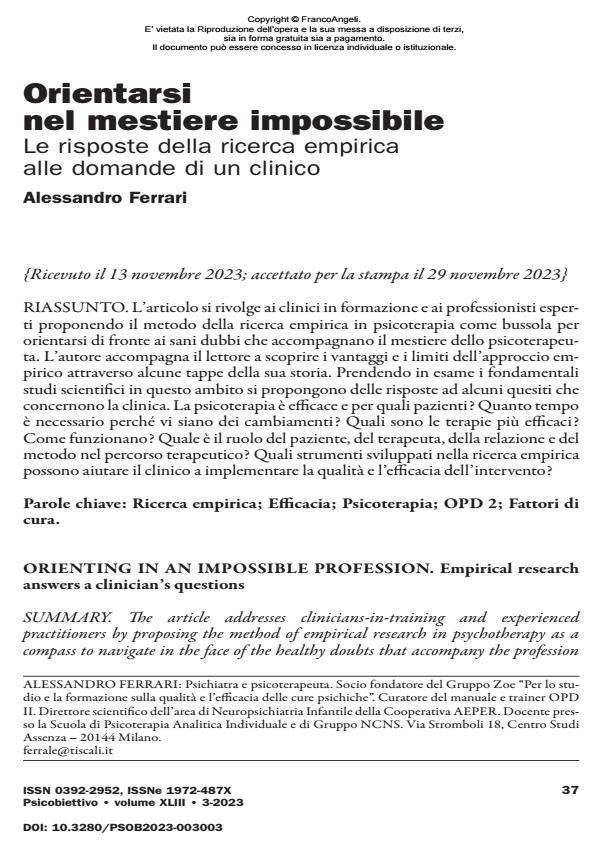Orientarsi nel mestiere impossibile Le risposte della ricerca empirica alle domande di un clinico
Titolo Rivista PSICOBIETTIVO
Autori/Curatori Alessandro Ferrari
Anno di pubblicazione 2024 Fascicolo 2023/3
Lingua Italiano Numero pagine 18 P. 37-54 Dimensione file 773 KB
DOI 10.3280/PSOB2023-003003
Il DOI è il codice a barre della proprietà intellettuale: per saperne di più
clicca qui
Qui sotto puoi vedere in anteprima la prima pagina di questo articolo.
Se questo articolo ti interessa, lo puoi acquistare (e scaricare in formato pdf) seguendo le facili indicazioni per acquistare il download credit. Acquista Download Credits per scaricare questo Articolo in formato PDF

FrancoAngeli è membro della Publishers International Linking Association, Inc (PILA)associazione indipendente e non profit per facilitare (attraverso i servizi tecnologici implementati da CrossRef.org) l’accesso degli studiosi ai contenuti digitali nelle pubblicazioni professionali e scientifiche
L’articolo si rivolge ai clinici in formazione e ai professionisti esperti proponendo il metodo della ricerca empirica in psicoterapia come bussola per orientarsi di fronte ai sani dubbi che accompagnano il mestiere dello psicoterapeuta. L’autore accompagna il lettore a scoprire i vantaggi e i limiti dell’approccio em- pirico attraverso alcune tappe della sua storia. Prendendo in esame i fondamentali studi scientifici in questo ambito si propongono delle risposte ad alcuni quesiti che concernono la clinica. La psicoterapia è efficace e per quali pazienti? Quanto tempo è necessario perché vi siano dei cambiamenti? Quali sono le terapie più efficaci? Come funzionano? Quale è il ruolo del paziente, del terapeuta, della relazione e del metodo nel percorso terapeutico? Quali strumenti sviluppati nella ricerca empirica possono aiutare il clinico a implementare la qualità e l’efficacia dell’intervento?
Parole chiave:Ricerca empirica; Efficacia; Psicoterapia; OPD 2; Fattori di cura.
Alessandro Ferrari, Orientarsi nel mestiere impossibile Le risposte della ricerca empirica alle domande di un clinico in "PSICOBIETTIVO" 3/2023, pp 37-54, DOI: 10.3280/PSOB2023-003003